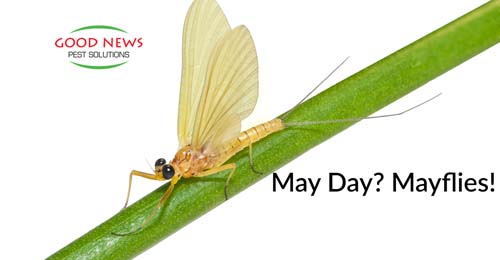
May Day? Mayflies!
As Spring quickly plows into our perpetual 80-degrees plus Summer, the month of May offers an opportunity to experience one of God’s stranger insect creations, the Mayfly.
Technically, ephemeroptera aren’t actual flies. They’re aquatic insects, more closely related to dragonflies and damselflies. And they’re not just active in May either. They’ll be around, sometimes as late as September, but since they first appear in May, that’s where their nickname comes from.
There are over 3000 species of mayflies, around 73 of which have been recorded in and around Florida. And the leading entomologists who have devoted their lives to the study of mayflies in Florida believe that there are at least 30 more species we haven’t yet confirmed. Most are found in freshwater streams and rivers, although a few species live in the brackish water of our marine estuaries.
A Day Well Spent
One of the most unusual characteristics of the adult mayfly is that it only lives for about 24 hours. Adult males get their wings and launch into swarms over or very near to the water in which they were born. Female adults will fly into the swarm of males where one will latch onto the female and mate in mid-air.
The female drops back down onto the surface of the water and lays her eggs. The eggs drop down into the water, attaching to stones or vegetation. They’ll linger there for a few days to a few weeks before they hatch. Then they molt into their nymph stage – which is where they spend the majority of their lives - one to two years. They feed on the organic material they find in the water, while fulfilling their place in the ecosystem, providing nourishment for fish and other insects.
Meanwhile, the adults perish shortly after mating. In fact, since they lack functional mouth parts or digestive tracts, it appears they were designed for a singular purpose.
All in a Day
For most of us, mayflies are not a concern. They are attracted to light and may swarm near lights on docks and buildings close to the water. Sometimes they’ll be drawn to gather in large numbers around homes and commercial buildings with bright lights.
If you do have an issue, you can change out your light bulbs – yellow CFL’s or, even better, LED’s will attract fewer bugs and are more efficient. A good screen door will keep most mayflies out of your home. For the ones that do get in, because of their short life span, a HEPA filter vacuum cleaner or even a broom and dust pan will work fine to eliminate the intruders.
A Day of Reckoning
A much bigger concern comes from a recent study that found that mayfly swarms are getting smaller. Remember, they are designed to be an essential part of the aquatic ecosystems we have across the Sunshine State. The decrease in their numbers not only affect the fish that feed on them - fewer mayflies could mean poorer water quality – and in many cases, harsh chemical insecticides may be to blame.
The good news is there are excellent risk-reduced remedies that are just as effective for treating annoying pests without being dangerous to ourselves or our world. For more than 30 years, Good News Pest Solutions has utilized the safest treatments available.
We’re committed to keeping you and your family safe, offering green solutions and stewarding the planet God gave us. If you’d like information on any of our services, or to schedule a free inspection of your property, just give us a call!
« Back to BlogProudly Serving
Sun City Center, Ruskin, Palmetto, Parrish, Ellenton, Bradenton, Anna Maria, Holmes Beach, Bradenton Beach, Longboat Key, Lakewood Ranch, University Park, Myakka City, Sarasota, Siesta Key, Osprey, Nokomis, Casey Key, Venice, Englewood, North Port, Port Charlotte, Punta Gorda, Arcadia
Things You Can Do
Pay Your Bill Online
Leave Us a Review
Request a Free* Termite Inspection
Stop Mosquito Bites
Get Rid of Rodents
Get a Termite Damage Warranty
Get Pest Control for Your Attic
Get Pest Control for Your Business Request Prayer
Corporate Address
1080 Enterprise Court, Ste A
North Venice, FL 34275
Call Now: (941) 412-9610
Text: (941) 412-9610
Fax: (941) 412-0080
